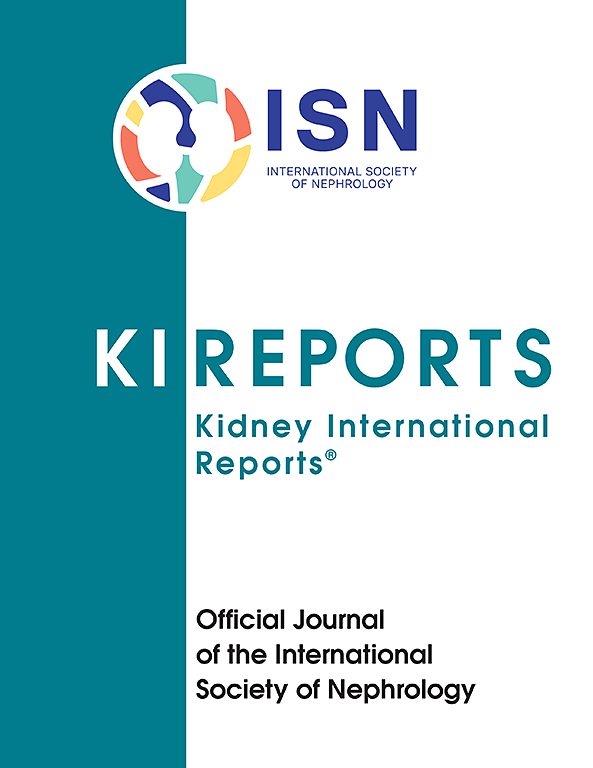Discordant Results Between Creatinine- and Cystatin C-based Equations for Estimating GFR
IF 5.7
2区 医学
Q1 UROLOGY & NEPHROLOGY
引用次数: 0
Abstract
Introduction
Discordant results between cystatin C and creatinine in estimating glomerular filtration rate (GFR) are an important medical issue. However, the equation that should be used when GFR estimates are discordant remains unclear.
Methods
This cross-sectional analysis included 15,485 participants with GFR measured by the clearance of an exogenous marker, serum creatinine, and cystatin C. We studied the proportion of discordant results defined as an absolute (> 15 ml/min per 1.73 m2) or relative (> 20%) difference between creatinine-based estimated GFR (eGFR, eGFRcrea) and cystatin C–based eGFR (eGFRcys) using different equations (Chronic Kidney Disease Epidemiology Collaboration [CKD-EPI], European Kidney Function Consortium [EKFC], and reexpressed Lund-Malmö [r-LMR]). We also researched for the best estimating equations to be used in subjects with concordant or discordant results to estimate measured GFR (mGFR).
Results
In the total cohort, the proportion of subjects with discordant results (absolute or relative) was larger for CKD-EPI (35.1 and 40.6%) than for EKFC (21.9 and 31.7%) or r-LMR (22.8 and 32.8%) equations. Among discrepant results, the proportion of eGFRcys < eGFRcrea was significantly higher than the proportion of eGFRcrea < eGFRcys for the CKD-EPI equations, whereas the occurrence of discrepancy was similar in the 2 discrepant groups for EKFC or r-LMR. For the EKFC and r-LMR equations, but not for the CKD-EPI, the equation combining creatinine and cystatin C was consistently the closest to the mGFR in the discrepant groups.
Conclusion
Based on the lower discrepancy proportion, better balance between eGFRcrea and eGFRcys, and better concordance with mGFR, the EKFC, and r-LMR equations should be preferred over the CKD-EPI to estimate GFR.

基于肌酐和胱抑素c的估算GFR方程的不一致结果
胱抑素C和肌酐在估算肾小球滤过率(GFR)时结果不一致是一个重要的医学问题。然而,当GFR估计不一致时,应该使用的公式仍不清楚。方法:该横断面分析纳入了15485名参与者,通过清除外源性标志物、血清肌酐和胱抑素c来测量GFR。15毫升/分钟每1.73平方米)或相对(>;20%)基于肌酐的估计GFR (eGFR, eGFRcrea)和基于胱他汀c的使用不同方程的eGFR (eGFRcys)之间的差异(慢性肾病流行病学合作[CKD-EPI],欧洲肾功能联盟[EKFC],以及重新表达Lund-Malmö [r-LMR])。我们还研究了在结果一致或不一致的受试者中用于估计测量GFR (mGFR)的最佳估计方程。结果在整个队列中,CKD-EPI结果不一致(绝对或相对)的受试者比例(35.1%和40.6%)大于EKFC(21.9%和31.7%)或r-LMR(22.8%和32.8%)方程。在差异结果中,egfrys的比例<;eGFRcrea的比例显著高于eGFRcrea <;CKD-EPI方程的egfrys,而EKFC或r-LMR的2个差异组的差异发生率相似。对于EKFC和r-LMR方程,而不是CKD-EPI,在差异组中,结合肌酐和胱抑素C的方程始终最接近mGFR。结论基于较低的差异比例,eGFRcrea和eGFRcys之间更好的平衡,以及与mGFR、EKFC和r-LMR方程更好的一致性应优于CKD-EPI来估计GFR。
本文章由计算机程序翻译,如有差异,请以英文原文为准。
求助全文
约1分钟内获得全文
求助全文
来源期刊

Kidney International Reports
Medicine-Nephrology
CiteScore
7.70
自引率
3.30%
发文量
1578
审稿时长
8 weeks
期刊介绍:
Kidney International Reports, an official journal of the International Society of Nephrology, is a peer-reviewed, open access journal devoted to the publication of leading research and developments related to kidney disease. With the primary aim of contributing to improved care of patients with kidney disease, the journal will publish original clinical and select translational articles and educational content related to the pathogenesis, evaluation and management of acute and chronic kidney disease, end stage renal disease (including transplantation), acid-base, fluid and electrolyte disturbances and hypertension. Of particular interest are submissions related to clinical trials, epidemiology, systematic reviews (including meta-analyses) and outcomes research. The journal will also provide a platform for wider dissemination of national and regional guidelines as well as consensus meeting reports.
 求助内容:
求助内容: 应助结果提醒方式:
应助结果提醒方式:


